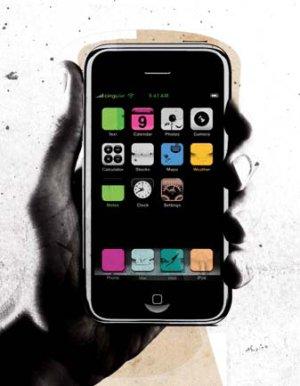Industry Focus -- The iPhone: Where now?
 By Ken Worsley
By Ken Worsley
Half-a-year on and the hype about iPhone Japan is ceaseless.
But can Apple really penetrate the Japanese market?
Amid a backdrop of media hoopla and attention, Apple’s iPhone was launched in Japan on July 11 this year. In the weeks leading up to the launch, commentators on both sides lined up to tell us why the iPhone would or would not succeed in Japan. The pro-iPhone camp mainly argued that two factors would lead to robust sales in Japan. First, it was often described as sort of “disruptive technology” that would offer Japanese consumers a product so different to what they were accustomed to that it would be guaranteed to generate interest, and thus sales. Second, much was written about the iPhone’s advantages in terms of usability, as many cell phone users would welcome a change from the confusing and overly complicated menu systems found in the software running the majority of domestic handsets.
 Will Apple be forced to localize the iPhone to suit the tough Japanese market?
Will Apple be forced to localize the iPhone to suit the tough Japanese market?
The other camp—those who predicted sluggish sales for the iPhone—tended to focus on what the device was missing in terms of features. At the time of its launch, the iPhone lacked support for several standard features commonly found amongst Japanese handsets, including 1-Seg television tuning, Osaifu Keitai electronic payments, infra-red data transfers, and emoji emoticon character input.
Thus, Apple entered the Japanese market with a globalized product. Although this approach worked for Apple’s own iPod, the lack of attention to the needs of the local market appears to have limited sales of the iPhone in Japan.
To what degree has it been limited? Again, we hear commentators arguing both sides of the issue, but exact figures for iPhone sales in Japan have not been released. In September, the Wall Street Journal cited data claiming that about 200,000 units had been sold in the two months following the iPhone’s release in Japan. The article went on to predict that Apple would fall short of the one million units it expected to sell in Japan by the end of 2008, as “analysts now widely believe sales are unlikely to reach a total of 500,000 units.” The article was unclear as to who the analysts were, who they worked for, and what those numbers were based upon.
A week after the Wall Street Journal article went to print, The Australian published an article citing Gerhard Fasol of Eurotechnology Japan, a telecom consultancy. Mr. Fasol told the newspaper that he expected 2008 total sales to fall between 645,000 and one million units.
It seems entirely plausible that Apple decided to launch the iPhone in Japan as a global product and then wait for feedback from users (and non-users) to decide which features would be added in future software and hardware upgrades. This approach seems likely given comments by Softbank CEO Masayoshi Son, who told reporters on October 8 that enough iPhones had been sold for the firm to begin gathering consumer feedback on product performance.
In an article published on October 21, the Nikkei hinted that problems with Apple’s iPhone have “tarnished the US firm’s image [in Japan].” The Nikkei noted that while the iPhone seems to be selling well, it had slipped from the top ten rankings of handsets by sales sometime in mid-September. The article went on to note that users were experiencing trouble with Apple’s “MobileMe” service, as well as the early termination of software applications. On the hardware side, defective rechargers had been sold which Apple was forced to replace for free in early October. The Nikkei article ended by saying that Apple would need to “quickly and drastically upgrade the iPhone’s quality” in order to keep up with the competition in Japan.
About a week after the Nikkei article was published, Softbank announced that it would start selling a wireless 1-Seg tuner from mid- December. The tuning device will allow for three hours of television watching, and doubles as a battery life extender. In addition, a firmware update from Apple has brought emoji to the iPhone. Softbank’s Son seemed to view the 1-Seg tuner as killing two birds with one stone, as short battery life and lack of 1-Seg functionality had been viewed as primary hurdles to further market penetration.
Still, this seems like a baby step toward achieving the goal of selling a product that will swim along with the competition in the Japanese handset market. The 80-gram wireless transmitter does not represent a seamless solution to the problem of not having a built-in tuner, and the idea of having to carry an extra battery to extend battery life seems to fall short of the ideal of having a built-in battery that would last longer. Quite simply, Softbank’s wireless tuner/battery extender does not represent the sort of elegant design and usability solution that Apple is so famous for.
Is the iPhone Japan now in a transition phase? Can we expect to see features for the domestic market to be seamlessly integrated into future versions of the phone? Given the features built into local competition, and Apple’s desire to grab a wider share of Japan’s $25 billion annual handset market, the future of the iPhone in Japan looks like a cost-benefit balance with increased development and production costs on one side, and the increase in potential sales on the other.
Ken Worsley is editor of Japan Economy News. He can be reached at japaneconomynews@gmail.com





